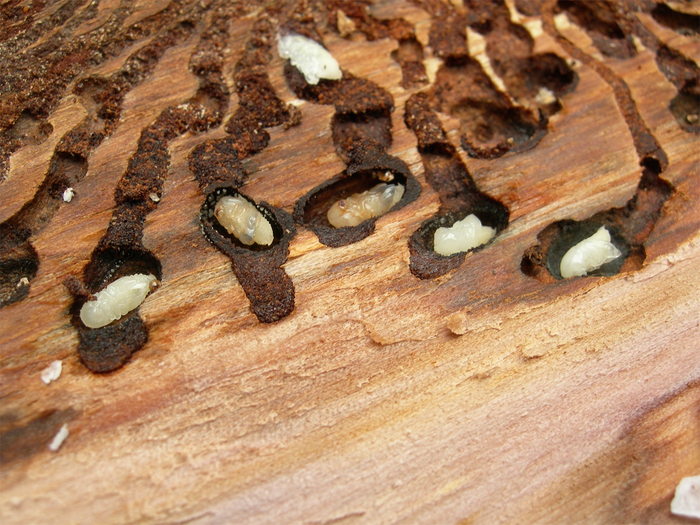Eurasian spruce bark beetles (Ips typographus) burrow into the bark of Norway spruce (Picea abies) trees where they mate and lay their eggs. Major outbreaks in Europe have decimated millions of hectares of conifer forests. The beetles preferentially attack trees that are already infected with symbiotic fungi (such as Grosmannia penicillata), which is thought to weaken host trees and break down their chemical defenses, allowing the beetles to successfully develop in the bark.

Credit: Dineshkumar Kandasamy (CC BY 4.0, https://creativecommons.org/licenses/by/4.0/)
Eurasian spruce bark beetles (Ips typographus) burrow into the bark of Norway spruce (Picea abies) trees where they mate and lay their eggs. Major outbreaks in Europe have decimated millions of hectares of conifer forests. The beetles preferentially attack trees that are already infected with symbiotic fungi (such as Grosmannia penicillata), which is thought to weaken host trees and break down their chemical defenses, allowing the beetles to successfully develop in the bark.
To investigate the chemical signals that the beetles use to identify host trees infected with the fungus, the researchers performed a series of laboratory experiments on captive bark beetles and samples of Norway spruce bark. They found that the fungus breaks down chemicals in tree bark resin, known as monoterpenes, into new compounds, including camphor and thujanol. After 12 days of infection, these fungus-produced compounds dominated the chemical mixture emitted by bark samples. Single cell recordings of sensory neurons in the beetles’ antennae showed that they can detect camphor and thujanol, and in behavioral experiments, bark beetles were attracted to bark containing the fungus-produced compounds.
Tree-resin derived compounds produced by the fungus may allow bark beetles to assess the presence of their symbiont, helping them to identify suitable sites for feeding and breeding. The authors say that understanding the role of these compounds in bark beetle attacks could be useful for pest-management strategies to protect European conifers from epidemic outbreaks.
Gershenzon adds, “The bark beetles currently killing millions of spruce trees every year in Europe are supported in their attacks by fungal associates. We discovered that these fungi convert volatile compounds from spruce resin to products, which may serve as cues for bark beetles to find them.”
#####
In your coverage, please use this URL to provide access to the freely available paper in PLOS Biology: http://journals.plos.org/plosbiology/article?id=10.1371/journal.pbio.3001887
Citation: Kandasamy D, Zaman R, Nakamura Y, Zhao T, Hartmann H, Andersson MN, et al. (2023) Conifer-killing bark beetles locate fungal symbionts by detecting volatile fungal metabolites of host tree resin monoterpenes. PLoS Biol 21(2): e3001887. https://doi.org/10.1371/journal.pbio.3001887
Author Countries: Sweden, Germany, South Africa
Funding: Financial support was provided by the Max Planck society to DK, RZ, YN, HH, AH and JG. MNA acknowledges funding from the Swedish Research Council FORMAS (grants #217-2014-689 and #2018-01444) the Crafoord foundation, the Royal Physiographic Society in Lund, and the Foundation in Memory of Oscar and Lily Lamm. The funders had no role in study design, data collection and analysis, decision to publish and writing.
Journal
PLoS Biology
DOI
10.1371/journal.pbio.3001887
Method of Research
Experimental study
Subject of Research
Animals
COI Statement
Competing interests: The authors have declared that no competing interests exist.




